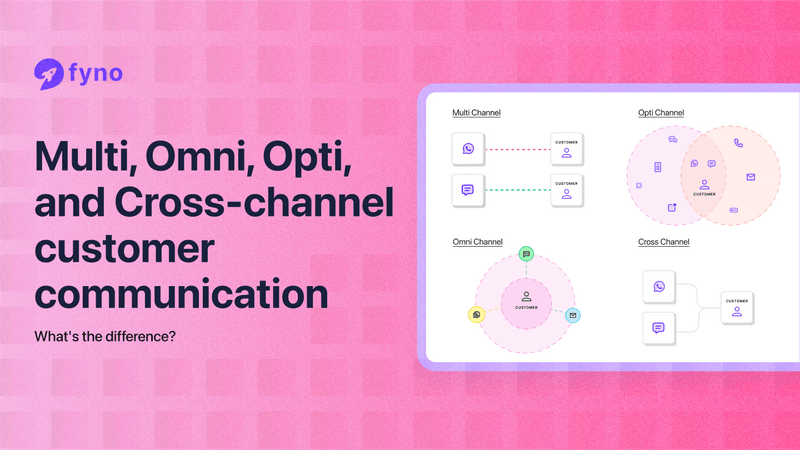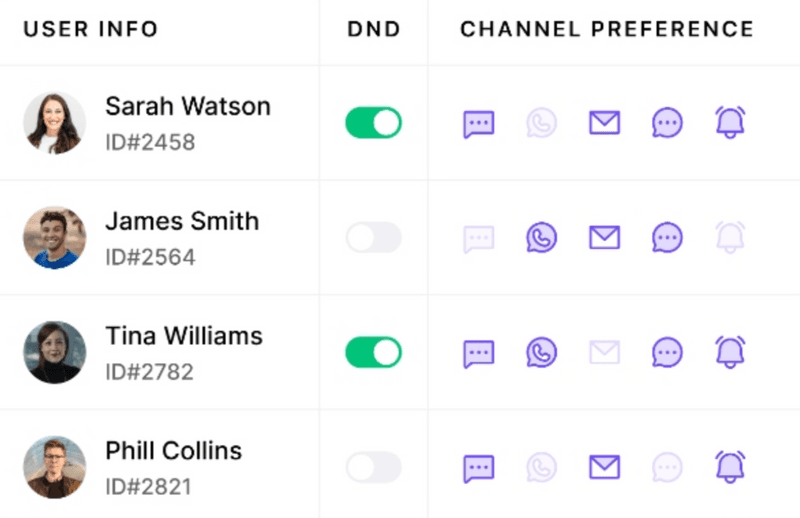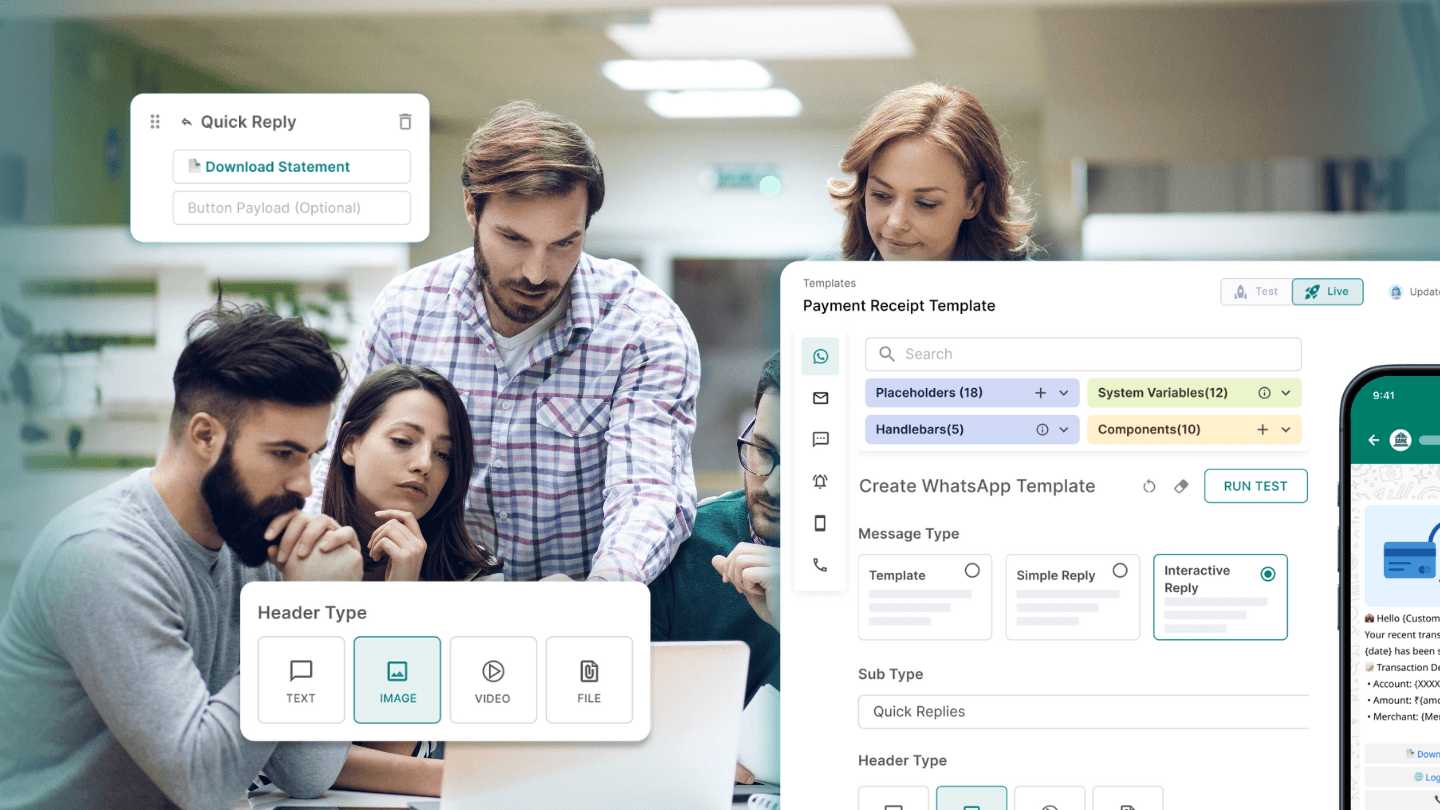Contents
- The evolution of customer communication
- What communication channels should you focus on today?
- What is multichannel communication?
- What is omnichannel communication?
- What is cross-channel communication?
- What is opti-channel communication?
- What are the core differences?
- What is the best approach for customer communication?
- The future of communications is opti-channel
- FAQs
If you’re crafting a customer communication strategy for your company, you’ll have to decide on two major aspects - the communication channels to reach out and connect with your customers, and the communication approach to send messages through the chosen channels. Just like the number of communication channels that have grown from two to over ten, the communication approaches have also increased in number.
Today, you have the option to choose between multichannel, omnichannel, opti-channel, and cross-channel strategies. But what do these terms mean? And, more importantly, which approach is the best fit for your business?
In this blog post, we’ll break down these terms, explore their differences, and help you decide the strategy that will resonate with your customers and drive your business forward.

The evolution of customer communication
Over the past two decades, the field of customer communication has undergone a dramatic transformation, largely driven by rapid technological advancements.
It can be argued that customer communication is one of the few domains that consistently leverages the benefits of fast-growing technologies, such as the internet, social media, and artificial intelligence (AI).
This proactive approach has led to the rise of numerous communication channels, enabling brands to effectively reach out to their customers.
In today's market, consumers expect companies to engage with them on their own terms and through their preferred channels. As a result, strategies like multichannel, omnichannel, cross-channel and even newer approaches like optichannel (which we discussed in our previous blog and will explore further in this article) have gained attention.
Before going on in-depth about all these strategies, let’s take a quick look at what communication channels you should focus on today.
What communication channels should you focus on today?
If you're new to setting up your customer communication strategy, here's a quick introduction to some widely used channels:
SMS
As the original communication channel from the beginning of the mobile phone era, SMS remains fast, direct, and personal, making it the most preferred channel for short message service, among customers. SMS is the best choice for sharing one-time passwords (OTPs), service messages, booking confirmations, and other time-sensitive information. However, the major limitation of SMS is that messages are limited to 160 characters, and you can only send text-based content.
Another long-standing communication channel, email has been around for over five decades and remains the most popular channel of preference among customers. In addition to allowing various media formats, emails give users control over whom to reply to, compared to giving out their personal phone numbers. Email is a great choice for sending newsletters, promotions, and other longer-form communication.
WhatsApp brings the power of multimedia to messaging, addressing the limitations of SMS and text messaging. It is fast, personal, and offers a wide range of customization options for brands. As a result, WhatsApp has become the most popular messaging platform after SMS and email, making it ideal for brands to send product updates, offer self-service options, and provide instant, personalized customer support.
Chat
When it comes to customer support, phone calls, email, and WhatsApp are considered the most preferred channels. However, many brands still offer live chat and chatbots to provide real-time assistance and engagement on their websites or apps. This targets a small group of customers who need instant help but aren't comfortable sharing their personal contact numbers (which is required for calls and WhatsApp).
Push notifications
The rise of smartphone adoption and the introduction of app marketplaces gave rise to push notifications as a new communication channel. Push notifications are a great way to instantly grab users' attention and deliver personalized messages. They offer a great deal of flexibility, allowing you to customize messages based on user activity, location, and subscription plan. However, the drawback of push notifications is that users can turn them off, making it difficult for you to reach your customers.
Voice
While voice is a more personalized way of communication, customers generally don't prefer brands calling them with offers. Hence, the voice channel is primarily used for urgent and important conversations or to resolve support issues faced by customers.
In-app messaging
In-app messaging is a simple and effective way to get the attention of your active users and seamlessly communicate with them directly within your mobile app. Due to the rise of emails during and post-COVID, email open rates (from brands) have dropped to an all-time low. In-app messaging is the best and most effective alternative for communicating with your users.
Web push
Web push notifications are a smart way to reach users even when they're not actively on your site. However, the major issue is that most users turn off web push notifications for most websites.
Now that we've covered the channels, let's dive into the strategies.
What is multichannel communication?
Multichannel communication, as the name suggests, involves using multiple communication channels to interact with your customers. It allows you to reach out to your audience through various touchpoints, such as SMS, email, WhatsApp, chat, and social media.
How does multichannel communication work?
In a multichannel approach, you engage with your customers across different channels, but each channel operates independently. This means that the messages you send through each channel are separate and not interconnected.
If you have multiple teams managing different channels, they may not have visibility into what the others are sending. As a result, customers might receive duplicate or inconsistent messages, leading to a disjointed and potentially frustrating experience.
Example of multichannel communication
Let's say a customer sends an email inquiry about a product. Later, they decide to call customer support for an update on their query.
In a multichannel setup, the phone agent might not have access to the email conversation, causing them to ask the customer to repeat their question. This lack of context can lead to repetition and frustration for the customer.
When should you choose multichannel?
Despite its limitations, a multichannel communication strategy can be a good starting point for businesses that want to expand their reach without investing heavily in channel integration. It allows you to establish a presence across multiple touchpoints and cater to customers who have distinct preferences for specific channels.
What is omnichannel communication?
Omnichannel communication takes successful multichannel communication strategy to the next level. It offers multiple channels for customer engagement, but ensures a seamless integration between all those channels.
With an omnichannel approach, your customers can enjoy a consistent and unified experience, regardless of the channel they choose to interact with your brand.
How does omnichannel communication work?
In an omnichannel setup, all your communication channels are linked together, allowing for a cohesive customer journey.
When a customer reaches out through one channel, the information is automatically shared across all other channels. This means that your team has access to the full context of the customer's journey, irrespective of the channel they are managing.
As a result, your customers receive a consistent, personalized, and a proactive customer experience.
Example of omnichannel communication
Let's revisit the example from the multichannel section. In an omnichannel approach, if a customer emailed a question and then called for an update, the phone agent would have immediate access to the email thread.
This allows the agent to provide a well-informed response, picking up right where the email conversation left off. The customer feels heard and valued, as they don't need to repeat their query, leading to a more satisfying experience.
When should you choose omnichannel?
Omnichannel communication is the ideal choice if you prioritize delivering a consistent, personalized, and seamless customer experience across all touchpoints. It's a more sophisticated approach that requires investment in technology and processes to ensure proper integration and data sharing among channels.
If your business has complex customer journeys that spans multiple channels and involves various teams, an omnichannel communication strategy can help you streamline your efforts and provide a superior customer experience. It's particularly valuable for businesses that aim to build strong, long-term relationships with their customers and foster brand loyalty.
What is cross-channel communication?
Cross-channel communication is similar to omnichannel in that it focuses on providing a seamless experience across multiple channels.
How does cross-channel communication work?
In a cross-channel setup, the communication channels are integrated, and the data is shared in real-time.
This means that if a customer starts a conversation on live chat and then decides to switch to SMS or email, the agent handling the interaction will have full visibility into the previous chat history. This enables them to pick up right where the conversation left off, providing a smooth and uninterrupted experience for the customer.
Example of a cross-channel communication
Imagine a customer is browsing the website of a D2C clothing brand. They initiate a live chat to inquire about sizing options for a particular dress. The online chat or agent provides the information, and the customer adds the dress to their cart. However, they get distracted and leave the website without completing the purchase.
Later, the customer receives a personalized WhatsApp message reminding them about the dress in their cart and offering a 10% discount if they complete the purchase.
The customer clicks on the link in the SMS, which takes them directly to their cart, and they complete the purchase.
When should you choose cross-channel?
Cross-channel communication is an excellent choice for businesses that want to provide flexibility and convenience to their customers.
If your customers tend to switch between channels frequently or if they prefer to communicate through multiple channels depending on their context (e.g., using live chat while browsing your website, but switching to SMS when on the go), cross-channel communication can help you cater to their preferences and enhance their experience.
Cross-channel communication is also valuable for businesses that have a complex sales or support process that may require multiple touchpoints across different channels. By ensuring that the conversation flows seamlessly across channels, you can provide a more efficient and satisfying experience for your customers.
What is opti-channel communication?
Opti-channel communication takes a step beyond omnichannel and cross-channel strategies by focusing on delivering the right message, through the right channel, at the right time for each individual customer.
It recognizes that not all communication channels are necessary for every message, emphasizing a more targeted and efficient approach to customer engagement.

How does opti-channel communication work?
It leverages insights into customer preferences, past interactions, and the nature of the communication to ensure that messages are not only received but are delivered in the way that the customer finds most convenient and engaging.
Example of optichannel communication
Consider a travel booking platform like MakeMyTrip. Each booking typically triggers a series of communications, such as confirmation emails, itinerary updates via SMS, and promotional offers through WhatsApp. With an opti-channel approach, the platform would analyze each customer's preferences and adjust the communication strategy accordingly.
For instance, if a customer consistently engages with promotional offers via email but rarely responds to WhatsApp messages, the system would prioritize email for sending marketing communications to that individual.
Similarly, if a customer has a history of promptly responding to urgent notifications via SMS, the platform would use SMS for time-sensitive messages like flight delays or cancellations.
By tailoring the channel selection to each customer's preferences and the nature of the message, opti-channel communication can help improve customer engagement, reduce communication costs, and enhance the overall customer experience.
When should you choose opti-channel?
If your business sends a high volume of customer communications across multiple channels, opti-channel can help you streamline your efforts and reduce costs by prioritizing the most effective channels for each message. This targeted approach can lead to higher open and response rates, improved customer satisfaction, and ultimately, better business outcomes.
What are the core differences?
Feature | Multi channel | Omni channel | Cross channel | Opti channel |
|---|---|---|---|---|
Customer Angle | Multiple channels, disjointed experience | Seamless, integrated experience | Switch channels seamlessly | Personalized, optimized experience |
System Complexity | Low | High | High | High |
Cost | Low | Medium | High | Medium |
What is the best approach for customer communication?
The “best” customer communication strategy depends on your business goals, budget, and customer expectations. However, when it comes to delivering a superior customer experience, opti-channel communication stands out as the most advanced and effective communications strategy around. Here’s how it scores based on various factors.
Customer service quality
By analyzing customer data and preferences, opti-channel systems can automatically select the best channel for each message, leading to higher open and response rates.
This targeted approach demonstrates a deep understanding and respect for customers' preferences, resulting in increased satisfaction and customer loyalty.
User preferences
Opti-channel communication puts the customer at the center of every interaction. By tailoring the channel selection to each individual's preferences and the nature of the message, opti-channel ensures that customers receive information in the way that is most convenient and engaging for them. This customer-centric approach shows that your business values their time, preferences, and overall experience.
Customer journey
By leveraging customer data and insights, opti-channel systems can anticipate customer needs and proactively deliver the right messages through the right channels at the right time. This level of personalization and efficiency helps to foster a stronger, more positive relationship between your brand and your customers.
Cost-effectiveness
In addition to improving customer experience, opti-channel communication can also help businesses reduce costs and improve efficiency. By prioritizing the most effective channels for each message, opti-channel can help companies avoid the expense of sending messages across every possible channel.
The future of communications is opti-channel
In today's competitive landscape, customers expect brands to understand their preferences and communicate with them on their terms. Opti-channel communication meets these expectations by ensuring that messages are delivered through the channels that customers prefer and are most likely to engage with. This targeted approach improves the chances of successful communication and demonstrates a deep commitment to customer satisfaction.
As technology continues to advance, opti-channel systems will become even more sophisticated, with the ability to analyze vast amounts of customer data in real-time and deliver increasingly personalized experiences.
Looking ahead, we can expect to see more businesses adopting opti-channel communication as a way to differentiate themselves and build stronger, more loyal customer relationships.
FAQs
1. What is the difference between multichannel and omnichannel communication?
While multichannel involves using multiple channels, omnichannel takes it further by seamlessly integrating those channels for a unified and consistent customer experience.
2. When should a business choose multichannel vs. omnichannel communication?
Choose multichannel if you're starting out and want a cost-effective way to reach customers across various platforms. It's a good option if you have limited resources and want to test different channels.
Choose omnichannel if you're ready to invest in providing a seamless, personalized customer experience across all touchpoints. It's ideal for businesses with complex customer journeys and the resources to integrate various communication channels.
3. How does cross-channel communication enhance customer experience?
Cross-channel ensures smooth transitions between channels, making complex interactions more efficient and customer-friendly.
4. What is the most effective alternative for communicating with users when email open rates are low?
In-app messaging is considered the most effective alternative for communicating with users when email open rates are low, especially for actively engaged users.
5. Why is opti-channel communication considered the most advanced strategy?
Opti-channel communication is considered the most advanced because it focuses on delivering personalized messages through each customer's preferred channels. By analyzing customer data and preferences, it ensures higher engagement rates, enhances satisfaction, and optimizes communication efforts.


